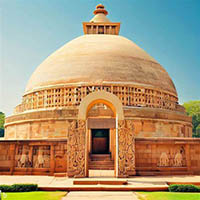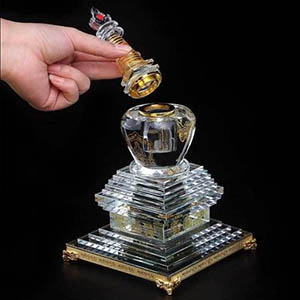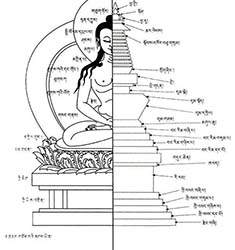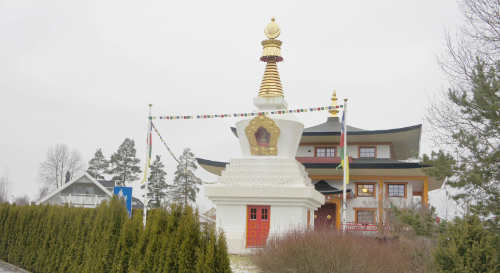|
|
|
| |
back to Tibetan Stupa main |

|
Tibetan Stupa
|
Stupas are tower-like structures which carry great meaning and
significance in Buddhist teaching and practice. Since the time the historical Buddha Shakyamuni taught, the basic shape
of a bowl on top of a square base has evolved into a variety of different shapes, some of which have taken on more or
less of the local style when Buddhist teaching spread to other countries from India.
 |
 |
|
The word stupa supposedly comes from the syllable „stup“,
which means heaped up in Sanskrit. This is related to the supposed origin of the stupa as having been developed out of ancient
tumuli, artificial hills heaped up on top of graves. According to tradition, the body of Buddha Shakyamuni was burned after
he entered Nirvana. The ashes were then kept in eight stupas at important places where the Buddha had taught.
From this evolved the practice to build stupas as representations of the Buddha and his teachings and as a treasure
trove for Buddhist treasures, such as relics, scriptures and ashes of great masters. In some way they can be described as
memorial structures that serve as tombs and a reminder of the teaching and its goal of enlightenment.
 |
 |
|
A typical Buddhist practice involving the stupa is circumventing it clockwise
from 7 to 108 to however many times. Constructing or repairing a stupa is also considered a practice to accrue merit to the practitioner.
The Indian Emperor Ashoka who was a devout Buddhist is said to have sponsored the construction of 84.000 stupas.
 |
 |
|
In the early days of Buddhism, no images of the Buddha himself were made and stupas became an abstract visual representation.
The body of the stupa is described as to representing the Buddha: The upper spire represents the crown.
Under it is a usually squared section which represents the head, which is why this section sometimes has eyes painted on it.
It is also called the harmika. The round section shaped like a bottle or vase is called the bumpa and represents the body of the Buddha.
The four steps or stairs under it are the legs of the Buddha and finally the actual base is his throne or seat of enlightenment.

|
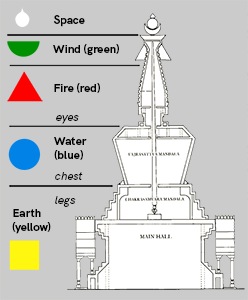 |
The meanings of the different levels of a Tibetan Stupa. |
|
 |
A typical Depending on the region and the branch or school of the Buddhist teaching,
additional symbolism is included into the structure of a stupa.
The Stahlhart Tibetan stupa depicts a typical Stupa as it can be found in all sizes and at all places wherever Buddhists
following the Tibetan branch are present. The version with doors and windows stands in Oslo, Norway. This version of the model
has an estimated scale. For all other versions, the scale is irrelevant, as such stupas exist in all kinds of sizes from tabletop
to multi-leveled tower. The Tibetans also assign other meanings to aspects of the stupa, such as the five elements plus space
to the legs, body, head, crown and tip. The 4 steps – considered the legs – also stand for the 4 immeasurables of loving-kindness,
compassion, joy and equanimity. There are also 8 major variants of the Tibetan Stupa, which differ slightly in their structure,
representing different stations in the live of a Buddha. The Tibetan Stupa from the Stahlhart model is the most common one,
representing enlightenment.
 |
| |
|
| |
|
|
| |
| return to top |


